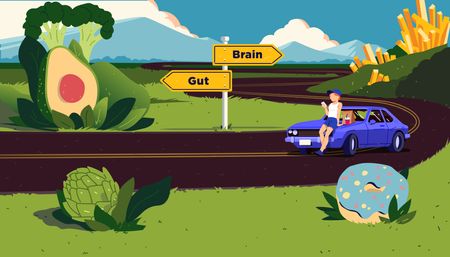Research shows that physical activity, especially cardio, is good for the body and the gut microbiome.
☝️DISCLAIMER☝️ This article is for informational purposes. Always consult your GP if you plan on implementing changes to your exercise routine, especially if you have been leading sedentary lifestyle with little or no physical activity.
In this article, we explain the relationships between gut microbial diversity and cardio, before reviewing exercise recommendations for health.
The microbiome is community of mostly bacteria that inhabits areas of the human body and perform beneficial functions for us, the hosts. The gut microbiome is of particular interest because it performs a range of functions that support health and reduce disease risk.
What is microbiome diversity?
Diversity is an essential parameter when measuring the health benefits of this ecosystem that lives in the colon. The gut microbiota comprises hundreds of species: its diversity contributes to health. But lack of microbial diversity creates an imbalance that can contribute to digestive distress and reduce disease protection conferred by a thriving ecosystem of gut bacteria.
☝️ The Atlas Biomed Microbiome Test uses genetic sequencing technology and the Chao1 index for precision analysis of your gut microbiome and its diversity.
Why is physical activity important?
Studies have shown, for example, that increasing the frequency of moderate exercise from never to daily inrceases the diversity among Firmicutes (including Faecalibacterium prausnitzii, Oscillospira, Lachnospira, and Coprococcus). Such microbes contribute to a healthier gut environment.
One major study conducted on elite rugby players demonstrated that exercise enriched the microbiome diversity. Now, scientists are looking closely at potential links between exercise, gut microbiome composition and how it affects disease.
☝️ Physical activity by itself is scientifically proven to reduce a number of multifactorial disease risks including cancers and preventable metabolic conditions like diabetes type II. It can also alleviate stress and depression while improving health, wellbeing and quality of life.
What type of physical activity can improve your microbiome?
It is used to measure endurance and can be improved with high-intensity exercises. VO2 max can account for more than 20% of the variation in taxonomic richness (diversity in types of bacteria identified), after accounting for all other factors, including diet. Studies showed that cardiorespiratory fitness was correlated with elevated gut microbial diversity regardless of what the participants ate.
Cardio exercise improves blood circulation and respiratory parameters, supplying oxygen to your muscles during prolonged physical activity. Sports that get your heart rate up and keep it up are considered "cardiorespiratory", like running, cross-country skiing, cycling, aerobic exercise, or swimming.
How much exercise do I need?
Here's what the NHS recommends for adult physical activity frequency:
- At least 150 minutes of moderate aerobic activity such as cycling or brisk walking every week
and - Strength exercises on 2 or more days a week that work all the major muscles (legs, hips, back, abdomen, chest, shoulders and arms)
OR
- 75 minutes of vigorous aerobic activity such as running or a game of singles tennis every week
and - Strength exercises on 2 or more days a week that work all the major muscles (legs, hips, back, abdomen, chest, shoulders and arms)
OR
- A mix of moderate and vigorous aerobic activity every week – for example, two 30-minute runs plus 30 minutes of brisk walking equates to 150 minutes of moderate aerobic activity
and - Strength exercises on 2 or more days a week that work all the major muscles (legs, hips, back, abdomen, chest, shoulders and arms)
☝️ Don't forget to stretch all the major muscle-tendon groups (a total of 60 seconds per group) 2 or more times per week to maintain the range of movement of your joints. You should also make sure to break up long periods of sitting by getting up and moving around.
Should I get a microbiome test?
You can learn more about the composition of your gut microbiome and how it affects your health with the Atlas Biomed Microbiome Test. The personalised health report includes:
- an overall score for microbiome functions and disease protection
- in-depth profile of your microbes and a probiotics report
- potential for nutrient synthesis including butyrate and vitamins
- ability to break down fibre and personalised food recommendations
We use advanced genetic sequencing to analyse your microbiome, generating results and recommendations using algorithms based on the results of thousands of clinical trials and scientific papers. This allows us to identify your individual traits and tailor recommendations for your unique body to enhance your health and wellbeing.
If you've already taken the test, here are links to your results and cool features in your personal account.
| Microbiome rating | Microbiota diversity |
| Dietary fibre metabolism | Butyrate synthesis potential |
| Microbiome composition | Probiotics & beneficial bacteria |
- American College of Sports Medicine position stand. Quantity and quality of exercise for developing and maintaining cardiorespiratory, musculoskeletal, and neuromotor fitness in apparently healthy adults: guidance for prescribing exercise.
- Cardiorespiratory fitness as a predictor of intestinal microbial diversity and distinct metagenomic functions.
- Endurance exercise and gut microbiota.
- Exercise modifies the gut microbiota with positive health effects.
- Differences in gut microbiota profile between women with active lifestyle and sedentary women.
- Gut microbiota modification: another Piece in the puzzle of the benefits of physical exercise in health?
- Metabolic equivalent.
- The diversity indexes.
- NHS Physical Activity Guidelines for Adults.


















